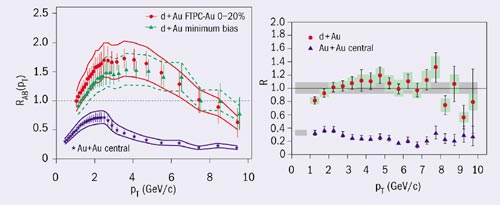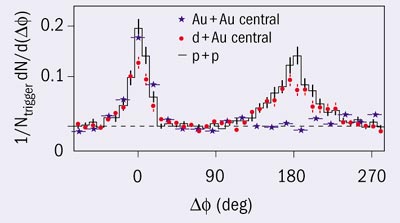New measurements at RHIC provide further insight into heavy-ion collisions at high energies.
Since it began operation three years ago, the US Department of Energy’s Relativistic Heavy-Ion Collider (RHIC) has produced an array of data that are rapidly shedding new light on unexplored territory in high-energy nuclear collisions. Results from the first gold-gold collisions at the new collider, recorded during the summer of 2000, immediately showed that the essential trend seen in fixed-target experiments at the Brookhaven AGS and CERN SPS continues as the collision energy is increased by an order of magnitude. Specifically, the concentration of energy deposited in the volume of space occupied by the colliding nuclei (the energy density) steadily increases with increasing collision energy. As a result, the multiplicity of particles produced in the most violent of the RHIC collisions is larger than any previously seen in subatomic interactions.

The early results have given clear indications that the origin of these particles involves extremes of density and temperature that are well into the range where the relevant degrees of freedom for nuclear interactions are expected to be those of quarks and gluons, not nucleons and mesons. Now it appears that measurements of high-energy phenomena due to the scattering of quarks and gluons in collisions of heavy nuclei have provided an important new means for probing the realm of the predicted quark-gluon plasma.
The RHIC collision energy is high enough to produce direct scattering of quarks and gluons from the incoming nuclei. In this “hard scattering” – in the parlance of quantum chromodynamics (QCD) – a single pair of partons (quark, anti-quark, gluon) from the incoming nuclei strike each other directly with such force that they scatter with high momentum away from the initial beam direction. These interactions, which are relatively rare even in the highest energy collisions, give rise to localized sprays of energetic particles called “jets”. These jets of hadrons are highly collimated along the axis of the initially scattered parton, and characteristically carry large components of momentum transverse to the axis of the colliding nuclei. Thus, while the average transverse momentum (pT) of hadrons produced in nuclear collisions is a few hundred MeV/c, hard-scattering processes in very high-energy collisions give rise to a small tail in the pT distribution that can extend out to tens of GeV/c.
Hard-scattering processes are well known in high-energy collisions of elementary particles, such as proton-proton collisions. Their observation was one of the early, compelling arguments for the existence of quark sub-structure in hadrons. By measuring the properties and momenta of the particles in a jet, one can reconstruct the kinematic and quantum properties of the initially scattered parton, and the measurements can be compared with readily calculable predictions of QCD.

These processes can now be seen at RHIC for the first time in nuclear collisions. They provide a direct signal of high-energy quarks or gluons emerging from the initial collision stage. Significantly, the early RHIC data from gold-gold collisions showed a deficit of high transverse-momentum particles from jets in collisions where the highest total number of particles is produced – that is, in the most violent collisions, where the evidence indicates that hot matter is formed. This effect, dubbed “jet quenching”, is one of the most striking indicators of possible new physics in these collisions.
It may be that the observed deficit of high-energy jets in these collisions is the result of a slowing down, or quenching, of the most energetic quarks as they propagate through a newly formed medium consisting of a dense quark-gluon plasma. If this is the case, then these measurements can provide a quantitative means of determining the properties of the primordial matter, in effect providing a direct probe of the plasma with beams of energetic partons.
First, however, it is important to verify this energy-loss interpretation of the observed jet quenching in gold-gold collisions. Recent theoretical work has conjectured that in very high-energy nuclear interactions the initial-state density of partons (mostly gluons) becomes so high that the effective number of interacting particles in the collision saturates, limiting the number of hard-scattering events. Thus, another possible interpretation of the paucity of jets might simply be that the wavefunction of a nucleus during a high-energy collision is significantly different from that of a superposition of nucleons.
The question of whether the observed jet quenching is the result of initial-state saturation effects or energy loss due to a dense final-state medium, can be checked experimentally by colliding a nucleon with a nucleus and seeing if there is a difference relative to nucleon-nucleon collisions. Effects due to initial-state saturation effects, which are intrinsic to the properties of the nucleus, will appear in these collisions of a small probe with a heavy nucleus, whereas those due to energy loss in a dense medium, which should only be produced after the collision of two heavy nuclei, will not appear. To provide this comparison, RHIC carried out a two-month programme of deuteron-gold collisions, beginning in March 2003, with each beam accelerated to 100 GeV/ nucleon (as in the gold-gold collisions).
In the first results from this run, all four of the RHIC experiments (BRAHMS, PHENIX, PHOBOS and STAR) produced data showing no indication of suppression at large transverse momenta for deuteron-gold collisions, clearly indicating that the initial-state effects are small, and the suppression effect observed at large transverse momentum in gold-gold collisions is indeed due to jet energy loss. This result is strikingly illustrated by the back-to-back correlation data from STAR (see figure). A recoil jet peak is present in deuteron-gold collisions, as it is in proton-proton collisions, but is suppressed in the gold-gold data.
The data analysed so far at RHIC give convincing evidence that high-energy collisions of heavy nuclei do indeed trigger the production of a hot, dense medium of final-state particles that is characterized by strong collective interactions at very high-energy densities. More needs to be done to determine the essential properties of this matter, but these latest results provide a major step toward unveiling the long-sought quark-gluon plasma.
Further reading
The first results on deuteron-gold collisions from the four RHIC experiments are to be published in Physical Review Letters. For the preprints see: www.arxiv.org/abs/nucl-ex/0306021 (PHENIX); nucl-ex/0306025 (PHOBOS); nucl-ex/0307003 (BRAHMS); nucl-ex/0307007 (STAR).








